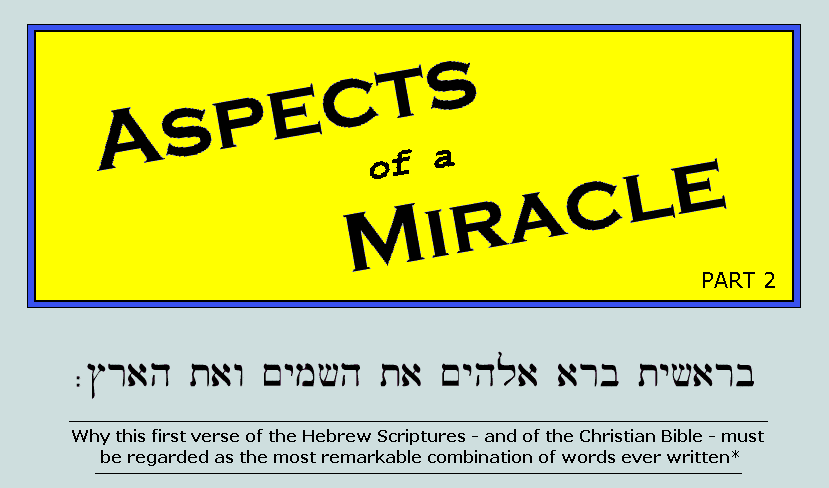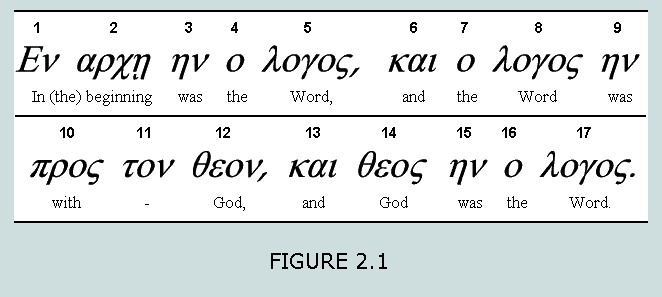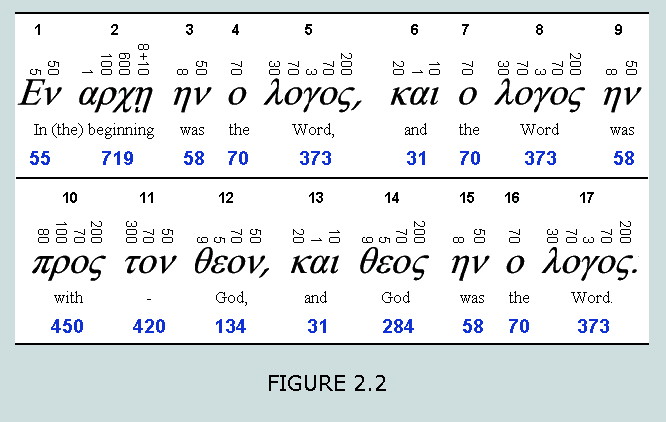

* Its translation in the KJV, the first of 31,102 verses
PART 1 - An Auspicious Beginning
[Please note: clicking on 'PART' opens the selected page whereas clicking on a page title opens a concise preview / recap of that page]
PART 2 - THE IMPRESSIVE PARTNERSHIP
2.1 - The Creation: a second biblical view
Despite the great time interval between their respective inceptions, it is clear that there exists a strong textual bonding between Genesis 1:1 and John 1:1. Here are the translations as they are found in the King James' Bible:
- "In the beginning God created the heaven and the earth."
- "In the beginning was the Word, and the Word was with God, and the Word was God."
For the Christian, these writings are highly significant and informative once the identity of "the Word" has been ascertained. The matter is resolved in John 1:14 where we read, "And the Word was made flesh and dwelt among us ...". Undoubtedly, then, Jesus Christ is 'the Word'; and because "All things were made by him..." (John 1:3), Jesus Christ is also 'the Creator'!
Clearly, taken together, these writings represent a solid basis upon which to build an effective apologetic.
As rendered in the original Greek this first verse of the Gospel of John reads (left to right) as follows:

There are 17 words comprising a total of 52 letters. A little explanation is required here concerning the structure of the second word where the last letter is seen to be subscripted by another, viz iota - this being the second element of a long vowel diphthong. Word 2 must therefore be regarded as a having 5 rather than 4 letters.
Since c600 BC each Greek letter has also functioned as a numeral [1]; accordingly, we may expand the given text to accomodate this feature, thus:

The values assigned in this scheme of alphabetic numeration are written above each letter. Each string of letters (the words, in this case) represents a number obtained by summing the associated letter values. These 17 results are recorded in blue beneath the translation. Observe the writing of '8 + 10' above the second word so as to accomodate the diphthong.
2.2 - Extending the Geometries - 1
The CV of John 1:1 (i.e. sum of the 17 word CVs) is 3627, or 3x3x13x31. Remarkably, following the example of Genesis 1:1 (where it was seen that 2701 = 37x73), these primes may be grouped to form the reflective pair, 39x93. Further, the sum 2701+3627 = 6328 = 112th triangular number! Thus, logically, 3627 takes on the form of the trapezium [2] represented below:
The trapezium has 39 rows - the topmost comprising 74 counters. Figure 2.4 reveals how this trapezium (representing John 1:1) engages with the 73rd triangle (representing Genesis 1:1) - to form what we may now conveniently refer to as 'the Greater Creation Triangle' (GCT). As an impressive 'plinth' to 'the Lesser Creation Triangle' (LCT) its primary function appears to be that of confirming and elevating LCT.
Figures 2.5 and 2.6 incorporate the additional alternative details of Genesis 1:1 as derived in the opening page of this series.
Observe here the overlapping plinths. In the darker blue we have that contributed by the first word of verse 2 - this obscuring the upper 4 rows of the John 1:1 sub-structure.
Further details of these structures and their significance may be found here.
2.3 - Two Primary Universal Constants
In mathematics, the sciences, and engineering, the two most widely known (and used) dimensionless constants are p (pi) and e. Both are transcendental numbers, i.e. neither can be defined exactly by the ratio of two integers, nor by any algebraic process - hence they are, inevitably, represented by approximations.
The first (p) is most famously involved in the mensuration of circle and sphere, and has been known from ancient times. Its value is 3.141592654... - commonly approximated by the simple fraction 22/7, or 3.142857... (error involved: + 0.04%).
The second (e) is of 18th century vintage and is known also as 'Euler's number'. It occurs naturally in any situation where a quantity increases at a rate proportional to its current value, such as a bank account producing interest, or a population increasing as its members reproduce.
Remarkably, good approximations of these fundamental constants may be derived from the scriptures: p from the Hebrew of Genesis 1:1, and e from the Greek of John 1:1, by means of identical procedures involving two ratios: (product of letter CVs) / (product of word CVs) and (number of letters) / (number of words). It is the product of these ratios that obtains these impressive results.
2.3.1 - The evaluation of p from within Genesis 1:1
The stated procedure delivers the value 3.1415545... - thus underestimating p (= 3.1415926...) by a mere 0.0012%. The full details are provided here.
2.3.2 - The evaluation of e from within John 1:1
The same procedure delivers the value 2.7183128... - thus overestimating e (= 2.7182818...) by a mere 0.0011%. The full details are provided here.
2.3.3 - Some observations on the p and e evaluations
Let us first reiterate the fact that any estimate of p or e that is obtained as the ratio of two integers must, necessarily, be an approximation. It is therefore interesting, and undoubtedly significant, that the errors involved in the foregoing derivations, viz -0.0012 and +0.0011, respectively, are small, are of the same order of magnitude, and are of opposite polarity.
It is appropriate that we derive a 'handle' on the kind of odds against this being a chance happening - bearing in mind the fundamental nature and close relationship of the sources involved. Here, again, are the first 8 digits of "estimate: true value" for p and e, respectively, with matching significant digits underlined:
3.1415545 : 3.1415926 and 2.7183128 : 2.7182818
Clearly, if these figures are rounded, both p and e are seen to be correct to 5 significant figures. Based upon a random distribution of the variables (a not unreasonable assumption in the circumstances), a simple estimate of the combined probability of these events may therefore be obtained as follows:
Since the first digit in each case could have been any one of nine in the range 1-9, and each of the remaining matching digits, any one of ten in the range 0-9, each event is associated with a probability of 1/90,000; and because they are independent, the final assessment is of the order of ten billion to 1 against them occurring fortuitously.
2.4 - Interim observations
Clearly, Genesis 1:1 and John 1:1 are related textually. But as has been demonstrated here, they are also related numero-geometrically via their fair readings as small sets of natural numbers based on the historically-attested Hebrew and Greek schemes of alphabetic numeration. This cohesion manifests itself in 4 distinct ways, thus:
- LCT (a G-triangle) combines precisely with John 1:1-as-trapezium to build another G-triangle, GCT
- the elemental of this triangle is the G-triangle, 703, which represents a translation of the words "...and the earth." and forms the central element of LCT
- the outline of GCT is the repdigit [3] 333 (a multiple of 37); that of LCT is the cube 216, or 6x6x6 - these are visually related
- applying a simple formula, the letter and word CVs of these verses deliver accurate values of two well-known universal constants
Their inclusion within God's Inspired Word is strongly suggestive of intent - to leave little room for doubt that He wishes us to experience, at first hand, the reality of His Being, and something of His Omniscience and Omnipotence.
Vernon Jenkins MSc
2009-02-26
email: vernon.jenkins@virgin.net
Note: the complete file of informative footnotes may be accessed here
PART 3 - Evidences of Inner Harmony may be found here